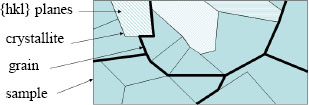Chapter 1
Some Basic Notions About Powder Diffraction
1.1. Crystallite, grain, polycrystal and powder
A polycrystal, dealing with diffraction, is a solid substance divided into very small homogenous particles, elementary single crystals called crystallites (Figure 1.1). Crystallites are tridimensional domains which propagate an incident x-ray or neutron wave in a coherent way without phase loss. Crystallites are also called “coherent domains” in crystallography. A grain (such as the ones we can observe using a microscope for instance) can be made up of many crystallites or only a single crystallite. A single crystal is then composed of only one crystallite, and a polycrystal of an ensemble of crystallites.
Figure 1.1. Definitions of grains (bold), crystallites (hatched zones) and crystallographic planes (hatchings) in a polycrystalline sample

A powder is an aggregate of crystallites (metal piece, ceramic, polymer or simply a compacted or not compacted powder) of varying number, shape, size and crystalline state, it is thus a polycrystal. But an ideal powder or “standard”, again concerning diffraction experiments, is made up of a large number (several tens of thousands at least) of crystallites in a perfect crystalline state (without microdistortion or any other defects) which exhibit a very narrow monomodal size and shape distribution. Furthermore, the standard powder has crystallites ...
Get Combined Analysis now with the O’Reilly learning platform.
O’Reilly members experience books, live events, courses curated by job role, and more from O’Reilly and nearly 200 top publishers.

